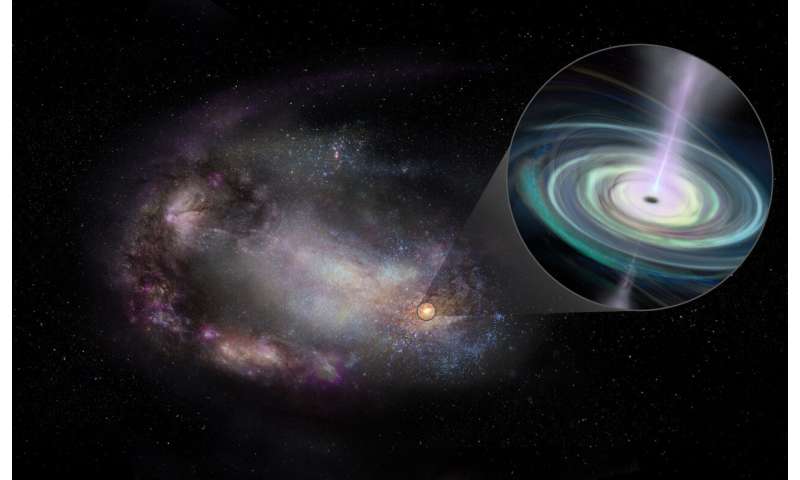
Astronomers seeking to learn about the mechanisms that formed massive black holes in the early history of the Universe have gained important new clues with the discovery of 13 such black holes in dwarf galaxies less than a billion light-years from Earth.
These dwarf galaxies, more than 100 times less massive than our own Milky Way, are among the smallest galaxies known to host massive black holes. The scientists expect that the black holes in these smaller galaxies average about 400,000 times the mass of our Sun.
"We hope that studying them and their galaxies will give us insights into how similar black holes in the early Universe formed and then grew, through galactic mergers over billions of years, producing the supermassive black holes we see in larger galaxies today, with masses of many millions or billions of times that of the Sun," said Amy Reines of Montana State University.
Reines and her colleagues used the National Science Foundation's Karl G. Jansky Very Large Array (VLA) to make the discovery, which they are reporting at the American Astronomical Society's meeting in Honolulu, Hawaii.
Reines and her collaborators used the VLA to discover the first massive black hole in a dwarf starburst galaxy in 2011. That discovery was a surprise to astronomers and spurred a radio search for more.

The scientists started by selecting a sample of galaxies from the NASA-Sloan Atlas, a catalog of galaxies made with visible-light telescopes. They chose galaxies with stars totalling less than 3 billion times the mass of the Sun, about equal to the Large Magellanic Cloud, a small companion of the Milky Way. From this sample, they picked candidates that also appeared in the National Radio Astronomy Observatory's Faint Images of the Radio Sky at Twenty centimeters (FIRST) survey, made between 1993 and 2011.
They then used the VLA to make new and more sensitive, high-resolution images of 111 of the selected galaxies.
"The new VLA observations revealed that 13 of these galaxies have strong evidence for a massive black hole that is actively consuming surrounding material. We were very surprised to find that, in roughly half of those 13 galaxies, the black hole is not at the center of the galaxy, unlike the case in larger galaxies," Reines said
The scientists said this indicates that the galaxies likely have merged with others earlier in their history. This is consistent with computer simulations predicting that roughly half of the massive black holes in dwarf galaxies will be found wandering in the outskirts of their galaxies.
"This work has taught us that we must broaden our searches for massive black holes in dwarf galaxies beyond their centers to get a more complete understanding of the population and learn what mechanisms helped form the first massive black holes in the early Universe," Reines said.
Reines worked with James Condon, of the National Radio Astronomy Observatory; Jeremy Darling, of the University of Colorado, Boulder; and Jenny Greene, of Princeton University. The astronomers are publishing their results in the Astrophysical Journal.
Explore further
Citation: Astronomers find wandering massive black holes in dwarf galaxies (2020, January 6) retrieved 6 January 2020 from https://phys.org/news/2020-01-astronomers-massive-black-holes-dwarf.html
This document is subject to copyright. Apart from any fair dealing for the purpose of private study or research, no part may be reproduced without the written permission. The content is provided for information purposes only.
https://news.google.com/__i/rss/rd/articles/CBMiSGh0dHBzOi8vcGh5cy5vcmcvbmV3cy8yMDIwLTAxLWFzdHJvbm9tZXJzLW1hc3NpdmUtYmxhY2staG9sZXMtZHdhcmYuaHRtbNIBR2h0dHBzOi8vcGh5cy5vcmcvbmV3cy8yMDIwLTAxLWFzdHJvbm9tZXJzLW1hc3NpdmUtYmxhY2staG9sZXMtZHdhcmYuYW1w?oc=5
2020-01-06 07:49:54Z
CAIiELZF32YztHjoRx4tjd0OAfIqFwgEKg8IACoHCAowpbDpAzCm_hwwj9kp
Bagikan Berita Ini














0 Response to "Astronomers find wandering massive black holes in dwarf galaxies - Phys.org"
Post a Comment